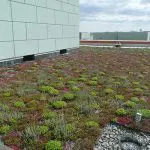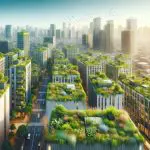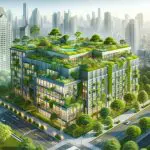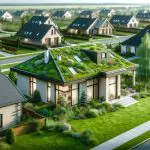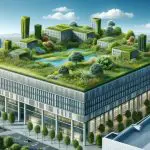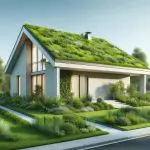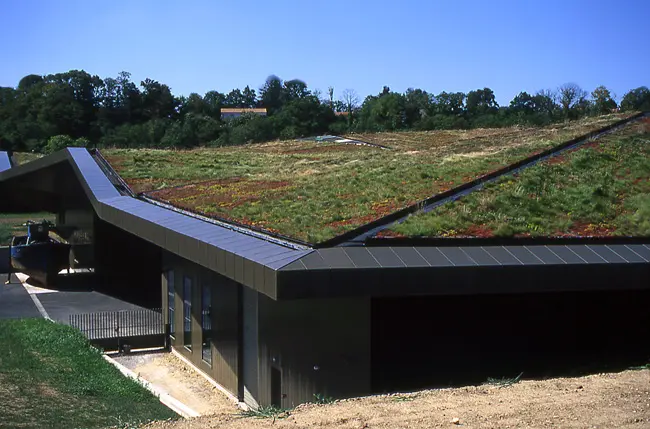
Discover the benefits of green roofs and how they transform urban spaces into lush, sustainable environments. Dive in for a greener future!
Green Roof Benefits Key Takeaways:
- Green roof benefits include improved air quality, energy savings, enhanced biodiversity, and reduced urban heat island effect.
- They absorb rainwater, reducing flood risk, and increasing property value.
- Green roofs also provide psychological benefits by creating peaceful, natural spaces in urban areas.
Ever wondered about the benefits of green roofs? These eco-friendly havens are not just about bringing more green into our cities; they’re about creating healthier, more sustainable environments.
Join us as we uncover the myriad advantages these rooftop gardens offer!
What is a Green Roof?
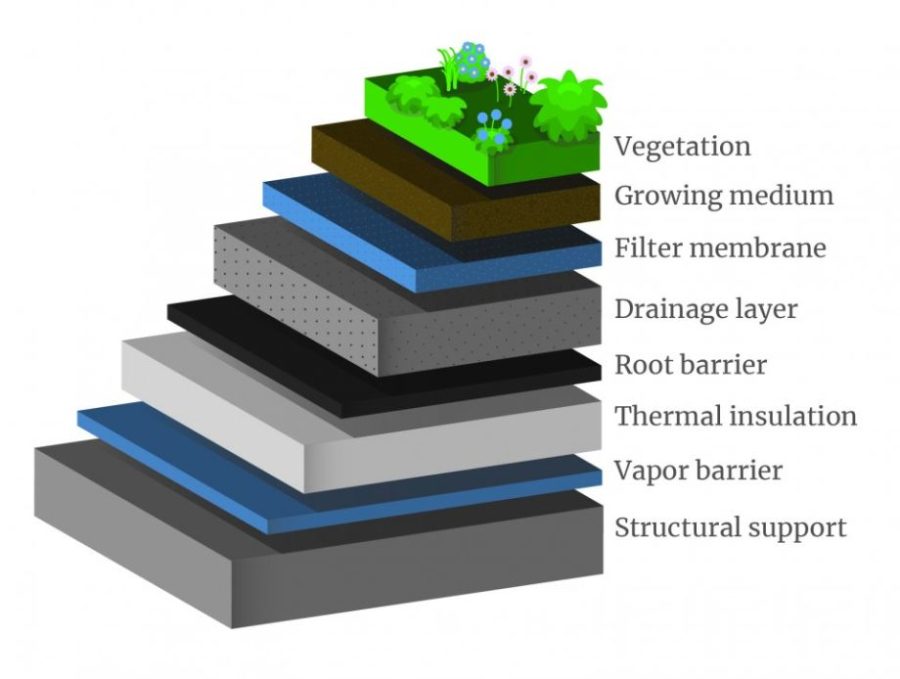
Wondering what a green roof is? It’s not a house with green-colored roofing. It’s a living roof on top of homes or other buildings.
A green roof or living roof is a roof of a building that is partially or completely covered with vegetation and a growing medium, planted over a waterproofing membrane. It may also include additional layers such as a root barrier and drainage and irrigation systems.
Container gardens on roofs, where plants are maintained in pots, are not generally considered to be true green roofs, although this is debated. Rooftop ponds are another form of green roofs which are used to treat greywater.Vegetation, soil, drainage layer, roof barrier and irrigation system constitute green roof. Wikipedia
What is a Green Roof? 10 Astonishing Innovative Facts
The Benefits of Green Roofs
Green roofs, a sustainable innovation in urban design, are transforming our concrete jungles into lush, green landscapes.
These living roofs are not just visually appealing; they offer a multitude of benefits, from environmental to economic.
In this exploration, we delve into the diverse advantages of green roofs, uncovering how they contribute positively to our urban environments and personal well-being.
This comprehensive guide aims to provide a deep understanding of why green roofs are more than just an aesthetic choice. They’re a smart, forward-thinking solution for our cities.
Economic Benefits of Green Roofs
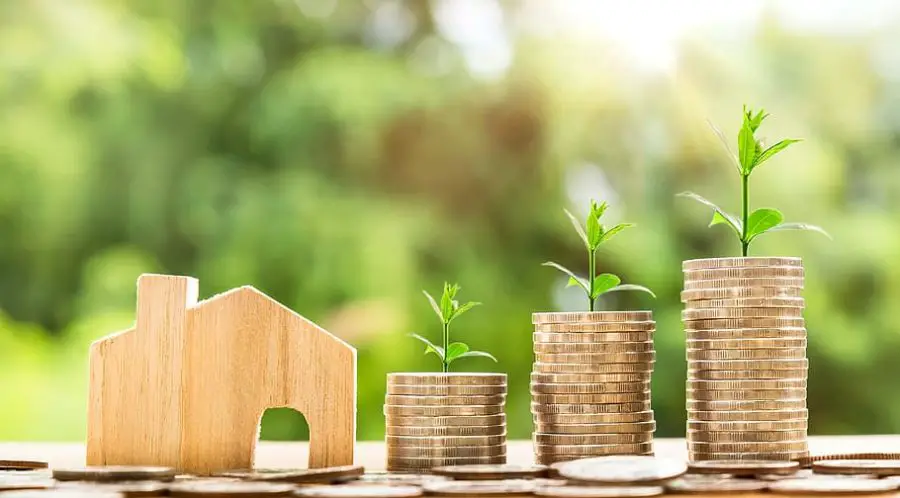
Enhancing Property Value and Efficiency
Green roofs are more than just an eco-friendly choice; they’re a smart investment.
By incorporating living greenery on your roof, you’re not only adding aesthetic value but also boosting the overall worth of your property.
This increase in value comes from several factors:
Improved Energy Efficiency
Green roofs play a critical role in energy conservation. By providing natural insulation, they reduce the need for heating and cooling in buildings.
This translates to significant energy savings, which is a boon for both the environment and your wallet.
Studies have shown that green roofs can lead to heating and cooling savings of about 20 to 25 percent.
Longevity of Roofing Materials
The lifespan of a green roof far exceeds that of a traditional roof.
Green roofs protect the underlying structure from harsh weather conditions and UV radiation, effectively doubling or even tripling the lifespan of the roofing material.
This means less frequent replacements and repairs, leading to substantial long-term savings.
Increased Solar Panel Efficiency
For those utilizing solar energy, green roofs offer an added benefit. The cooler environment created by green roofs enhances the efficiency of solar panels, further reducing energy costs and increasing sustainability
Ecological and Environmental Benefits of Green Roofs
A Boon for Urban Ecosystems
Green roofs are not just a visual delight; they’re a crucial element in enhancing urban ecosystems.
By integrating nature into the urban landscape, these roofs provide numerous ecological and environmental advantages.
Air Purification and CO2 Reduction
One of the most vital roles of green roofs is their contribution to air quality.
The plants on green roofs actively filter particulate matter from the air and convert carbon dioxide into oxygen, thus directly contributing to air purification and mitigating air pollution.
Mitigating the Urban Heat Island Effect
Green roofs address the issue of the urban heat island effect, where urban areas experience significantly higher temperatures than their rural counterparts.
By absorbing sunlight and reflecting heat, green roofs help cool the surrounding environment, potentially reducing city-wide ambient temperatures by as much as 5℉.
Stormwater Management
In the face of increasing urbanization and climate change, managing stormwater runoff becomes critical.
Green roofs absorb and retain rainwater, thereby reducing the burden on city drainage systems.
This capacity to hold and gradually release water not only reduces the risk of urban flooding but also ensures that any runoff is cleaner, having been naturally filtered through the roof’s vegetation.
Fostering Biodiversity
Urban areas, often dominated by concrete and asphalt, lack sufficient green spaces for wildlife.
Green roofs provide a haven for various species, including birds, insects, and native plants, thereby enriching urban biodiversity.
This addition of greenery in cities helps create a more balanced and healthy ecosystem.
Societal and Psychological Benefits of Green Roofs
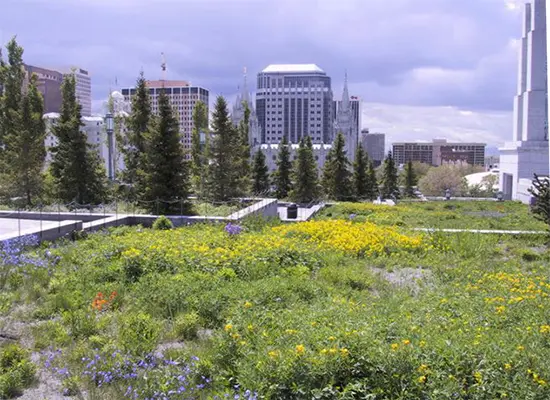
Enhancing Quality of Life in Urban Areas
Green roofs aren’t just about improving our physical environment; they also have significant impacts on societal well-being and mental health.
This section explores how these living spaces contribute to the social fabric and psychological health of individuals in urban settings.
Noise Reduction and Creation of Peaceful Spaces
One lesser-known but equally important benefit of green roofs is their ability to reduce noise pollution.
Acting as natural sound barriers, they absorb ambient noise, creating quieter and more serene urban spaces.
This feature is particularly beneficial in densely populated areas, where noise pollution can be a constant challenge.
Health Benefits: Stress Reduction and Healing Environments
Living and working in proximity to green spaces have been shown to have a profound impact on mental health.
Green roofs offer a much-needed connection to nature in urban environments, providing spaces for relaxation and stress reduction.
Moreover, studies have found that green environments can facilitate faster recovery for patients and increase pain tolerance, contributing to what’s known as a ‘healing environment’.
Social Cohesion and Community Engagement
Green roofs can also play a role in enhancing community bonds.
They provide shared spaces that encourage social interaction and foster a sense of community.
In neighborhoods with more green spaces, there’s often a noticeable improvement in social cohesion and a reduction in problems like aggression and vandalism.
These societal and psychological benefits demonstrate how green roofs can significantly enhance the quality of life in urban areas.
Practicality and Maintenance of Green Roofs
Making Green Roofs a Viable Option
While the benefits of green roofs are extensive, understanding their practicality and maintenance requirements is crucial for their successful implementation.
This section aims to demystify the installation and upkeep of green roofs, making them a more accessible option for urban development.
Ease of Installation and Maintenance
Contrary to popular belief, the installation of green roofs can be straightforward, especially when using pre-cultivated vegetation blankets.
These blankets not only simplify the installation process but also ensure immediate coverage and minimal maintenance needs, thereby saving time and reducing long-term costs.
Wind and Erosion Resistance
In areas prone to high winds, green roofs offer an additional benefit.
The vegetation blankets used in green roofs provide a solid, erosion-resistant top layer, ensuring that the substrate remains intact even during storms.
This characteristic makes green roofs an ideal choice for buildings in windy locales.
Durability and Longevity
Green roofs contribute to the durability and longevity of the building itself.
By protecting the roofing material from external factors like sun, rain, wind, and temperature fluctuations, green roofs can significantly extend the life of a roof for up to 60 years or more.
This aspect not only makes them a sustainable choice but also a financially sound investment in the long run.
The practicality and maintenance section highlights how green roofs are not only beneficial but also feasible and sustainable for urban buildings.
Design Considerations and Types of Green Roofs
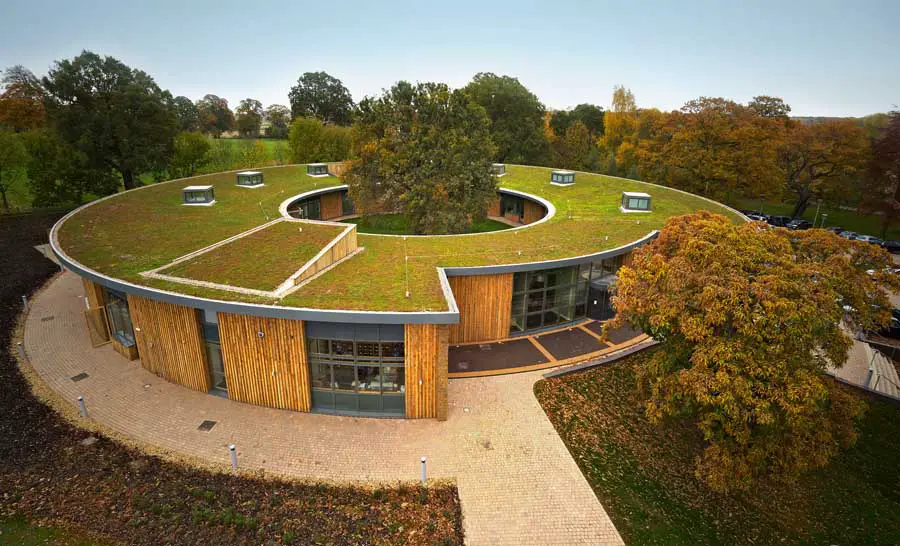
Crafting the Perfect Green Oasis
When it comes to green roofs, one size does not fit all. The design and type of a green roof can vary significantly, depending on the building’s structure, climate, and the desired benefits.
Let’s explore the main types of green roofs and their key design considerations.
Extensive Green Roofs: The Low Maintenance Choice
Extensive green roofs are characterized by their lightweight, low-maintenance design.
They typically feature a shallow growing medium, usually around 3-6 inches deep, and are planted with hardy, drought-resistant vegetation like sedums and wildflowers.
These roofs are ideal for large areas where accessibility is limited and are excellent for providing environmental benefits with minimal upkeep.
Intensive Green Roofs: The Lush, Park-Like Gardens
Intensive green roofs, on the other hand, are like elevated parks.
With a deeper soil layer, usually over 6 inches, they can support a wide variety of plants, from grasses and flowers to shrubs and even trees.
These roofs require more maintenance, similar to a traditional garden, and are often designed with walkways and seating areas, making them perfect for recreational purposes.
Semi-Intensive Green Roofs: A Blend of Both
Semi-intensive green roofs offer a middle ground, combining elements of both extensive and intensive designs.
They typically have a moderate soil depth and can support a greater variety of plants than extensive roofs while requiring less maintenance than intensive roofs.
Designing for Climate and Building Specifications
When designing a green roof, it’s crucial to consider the local climate and the building’s structural capacity.
The choice of plants, soil depth, irrigation, and drainage systems must be tailored to withstand local weather conditions and the weight-bearing capacity of the building.
Future Trends and Predictions in Green Roofing
Green Roofs: Looking Ahead
As green roofs continue to gain popularity, we’re likely to see exciting developments and trends in the coming years.
Here’s a glimpse into what the future might hold for green roofing.
Technological Integration
Advancements in technology are set to play a significant role in the evolution of green roofs.
From smart irrigation systems that optimize water usage to sensors that monitor soil health and plant growth, technology will make maintaining green roofs more efficient and environmentally friendly.
Biodiverse and Ecosystem-Specific Designs
The trend towards biodiversity will continue, with designs increasingly focusing on creating mini-ecosystems that support local wildlife.
This approach not only enhances the ecological value of green roofs but also ensures they are more resilient and sustainable.
Policy and Urban Planning Integration
As awareness of the benefits of green roofs grows, we can expect to see more policies and urban planning strategies that encourage their implementation.
This might include incentives for building owners, integration in new developments, and inclusion in urban green space planning.
Multi-Functional Spaces
Green roofs are evolving beyond just being a sustainability feature.
They are becoming multi-functional spaces for urban agriculture, recreational areas, and even venues for community events and educational programs.
Climate Change Resilience
In an era of climate change, green roofs will be increasingly valued for their role in making cities more resilient.
They can help manage stormwater, reduce urban heat islands, and improve air quality, all of which are critical in adapting to changing environmental conditions.
FAQs about Green Roofs Benefits
Green roofs, with their rising popularity and diverse benefits, naturally evoke curiosity and questions.
This section addresses some of the most frequently asked questions about green roofs, providing clear and concise answers to help deepen understanding and dispel any misconceptions.
Q: How do green roofs contribute to energy savings?
A: Green roofs play a significant role in energy conservation. By providing natural insulation, they reduce the need for heating in winter and cooling in summer, leading to substantial energy savings.
On average, green roofs can cut down air conditioning use by up to 75% and heating usage by 23%.
Q: Can green roofs help in urban biodiversity?
A: Absolutely! Green roofs create habitats for a variety of wildlife, including birds, insects, and native plants.
They are particularly beneficial in urban areas, where natural habitats are limited.
By introducing green roofs, cities can significantly enhance their biodiversity, contributing to a more balanced urban ecosystem.
Q: What are the maintenance requirements for green roofs?
A: The maintenance of green roofs varies depending on the type of green roof installed.
Generally, extensive green roofs, which are more common and have low-growing vegetation, require minimal maintenance.
This includes occasional weeding, watering during dry periods, and ensuring proper drainage.
Intensive green roofs, which are more like traditional gardens, require more regular maintenance similar to ground-level gardens.
Conclusion: Embracing the Future with Green Roofs
A Step Towards Sustainable Urban Living
As we conclude our exploration of the benefits of green roofs, it becomes evident that these living green roof systems are more than just a trend.
They are a vital step toward sustainable urban development.
By integrating green roofs into our cities, we not only enhance the aesthetic appeal of our buildings but also contribute significantly to environmental conservation, economic savings, and societal well-being.
A Multifaceted Solution
Green roofs address a range of urban challenges from air pollution and the heat island effect to stormwater management and biodiversity loss.
They are a testament to how innovative, nature-based solutions can transform our urban landscapes for the better.
Long-Term Benefits
The long-term economic, ecological, and social benefits of green roofs far outweigh their initial installation and maintenance costs.
They represent a wise investment in the future of urban living, offering a sustainable solution that pays dividends for generations.
A Call to Action
As individuals, community leaders, and policymakers, the decision to embrace green roofs can lead to healthier, more resilient cities. It’s an opportunity to be part of a greener, more sustainable future.
Using Green Roofs to Reduce Heat Islands | US EPA
What Is a Green Roof? | The Family Handyman

